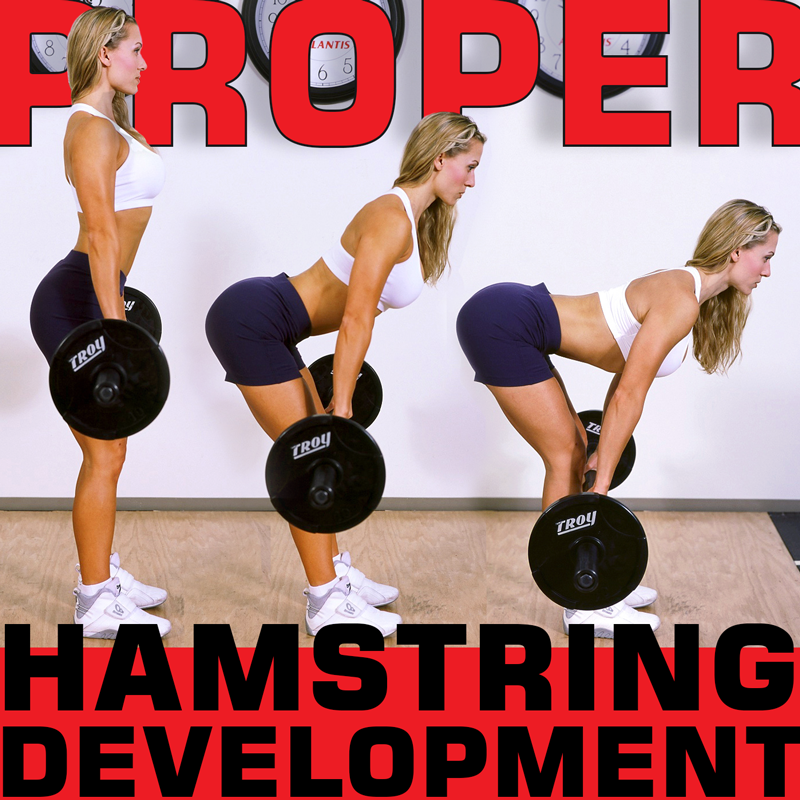Think Twice about Romanian Deadlifts

by Kim Goss, MS
Despite advanced sports medicine care and the best-of-the-best coaching staffs, there were a reported 45 hamstring injuries during the first three weeks of the 2019 NFL season! Further, one 10-year study on NFL players found that hamstring injuries were the #2 injury behind knee injuries. But it’s not just football players who are frustrated. With pretty much any sport that involves sprinting, it’s often not a question of “if” you will pull a hamstring, but “when.”
For over four decades, BFS has taken a multi-faceted approach to prevent hamstring injuries. In addition to a stretching program that addresses both hamstring and hip flexor tightness, the BFS program includes many weight room exercises that strengthen the hamstrings, including glute-ham raises, hex bar (or straight-bar) deadlifts, squats, straight-leg deadlifts, and Olympic lifting movements such as cleans. Why so much attention to a single muscle group? Besides helping to prevent injuries, hamstring development is critical for improving speed.
One of the distinguishing characteristics of elite sprinters is that they spend less time on the ground. Whereas an average person will spend .12 seconds on the ground when they run at top speed, an elite sprinter is often 33 percent faster with just .08 seconds of ground-contact time. When Usain Bolt ran his 9.58 in the 100 meters, he produced half the amount knee flexion as Dwain Chambers, who finished that race in 10.00. Such short ground contact time is often attributed to his superior leg and hip strength, but there is much more to consider -- tendons also play a significant role in producing power.
One of the reasons kangaroos are so efficient at hopping is that they have long tendons that can store up to 10 times more energy than their muscles. In sprinting, as the hamstring tendons shorten, the attached muscles must lengthen, or they can tear. Performing plyometrics and explosive exercises such as cleans, which are included in the BFS Total Program, will help train the tendons to quickly stretching and shorten in a coordinated manner with the muscles that prevent injuries. Let me share with you an extreme example.
A colleague of mine who was an assistant coach at a college said that during his first year on the job, the new head strength coach for the football team decided it wasn’t necessary for his athletes to sprint in the off-season. Instead, he has his athletes focus on strongman training. He even wrote articles about his training methods, using photos of his athletes. The result? The football team suffered more than two dozen hamstring pulls by the end of spring ball! This high rate of injury suggests that strongman exercises alone do not train the muscles and tendons to contract and relax quickly in a coordinated fashion.
Of course, strength coaches are always looking for an edge, and as such many have decided that the hamstrings require additional work with the regular performance of the so-called “Romanian deadlift.” I’m going to make the case that this exercise may be doing more harm than good, especially if they use it in place of conventional exercises that work the hamstrings.
The popularity of the Romanian deadlift (RDL) can be traced to Nicu Vlad, a Romanian weightlifter who won the Olympics in 1984 and broke two world records in the snatch. As such, weightlifters and their coaches were especially interested in how he trained – they found out during a weightlifting seminar held in San Francisco at Jim Schmitz’s Sports Palace in 1990. Vlad was one of the presenters, along with his coach Dragomir Cioroslan.

Vlad put on a show during the seminar, clean and jerking a reported 507 pounds, then finished off with a unique variation of the deadlift. Rather than pulling the barbell from the floor, he performed it from the top down. Throughout the movement, his lower back remained arched and his knees slightly bent. Vlad worked up to 551 pounds for triples.
Vlad and Cioroslan were asked by those in attendance what they called the exercise, but they didn’t have an answer. Schmitz spoke up and said they should call it the Romanian deadlift, “and everyone agreed -- and there you have the birth of the RDL.”
The endorsement of this weightlifting legend may be enough for many strength coaches to prescribe it to their athletes, but I decided to investigate. After all, at that time I had been involved in weightlifting for 18 years and had never heard of it. Was this, perhaps, a secret exercise that Eastern Bloc countries were keeping to themselves to give their athletes an edge? Short answer: No.
My credible source to get to the bottom of this mystery was Bud Charniga, an American weightlifting sports scientist who came within five pounds of breaking the national record in the snatch in the heavyweight division. Charniga had attended dozens of international weightlifting competitions and had watched in-person numerous training sessions of European weightlifters, including those from Romania. He is also an expert in Russian training methods, having translated over a dozen Russian weightlifting textbooks, publishing them under his company, Sportivny Press.
Charniga has written extensively about the importance of the hamstrings in the sport of weightlifting, but when I asked him how widely-used the RDL was among European weightlifters, he replied, “I’ve been to many world and European championships, and I rarely see anybody doing anything that resembles a Romanian deadlift.” Speculating as to why, Charniga said that the most common weakness for a lifter is the pull from the floor to the knee, not the pull after the bar passes the knees. For this reason, he says you often see elite weightlifters performing deadlifts with a wide grip, or deadlifts with a clean grip while standing on a low platform or a bumper plate.
At BFS, we treat the body as one piece, rather than a muscle-to-muscle approach as you would in bodybuilding. Applying this concept to the biomechanics of weightlifting, Charniga says there is a fundamental motor learning issue with a weightlifter performing the Romanian deadlift as a core exercise: It trains you to use your trunk more than your legs.
“In a Romanian deadlift, you’re doing something where you’re moving your trunk in isolation – your legs stay still – and, as a result, it has a negative transfer to the pull,” says Charniga. “In weightlifting you’re trying to use your legs throughout the whole movement, rather than passively using your legs as is done during a Romanian deadlift. This exercise has nowhere near the coordination structure of a snatch or clean, and, as such, I would strongly discourage any lifter from performing it.”

Using real-world evidence, consider the pulling technique of the Chinese weightlifters who have dominated the sport for more than a decade. The RDL has the shoulders move well in front of the bar (putting extreme stress on the spine). During the Chinese pull, the shoulders start directly over the bar and then move behind them. In effect, they have reduced the involvement of the lower back in the pull to place more emphasis on the strength of their legs. (Likewise, BFS prefers the hex bar deadlift to the straight-bar deadlift as it places less stress on the lower back.)
Regarding the Romanian deadlift as a hamstring strengthening exercise, consider that the hamstrings work both as hip extensors and knee flexors (which is why BFS likes the glute-ham raise as a total hamstring exercise!). The focus of the RDL is on hip extension.
TURN YOUR PROGRAM AROUND!
Weight Room Safety/Strength Certification Online!
Improve athletic performance AND weight room safety.
The proven BFS Total Programis the best way to train Students and Athletes. Make this winning program part of your training. With 6 video modules, over 5 hours of content, online theory test, this certification is the complete course.
According to Canadian posturologist and strength coach Paul Gagne’, the RDL focuses on the proximal part of the hamstrings (closer to the glutes). He’s found in his nearly 30 years of coaching and working with elite sports medicine practitioners, it’s usually the distal part of the hamstrings (closer to the knee), that gets injured in sprinting. In fact, in one study of 170 athletes with hamstring injuries, 80 percent of the injuries were to this area.
“If you look at American football players, often you’ll see that they are heavily-muscled around the upper thighs and glutes, but lack relative development in the muscles around the knee,” says Gagne’. “This can be a result of concentrating on exercises such as hang power cleans and partial low-bar squats that resemble good mornings.”
Another factor Gagne’ says contributes to hamstring pulls is poor posture. This is why BFS recommends regular stretching of the muscles that flex the hip, as tightness in this area can create an excess anterior (forward) pelvic tilt. “Such misalignment creates additional tension on the hamstrings, increasing in severity at the bottom of the RDL. It’s one thing to occasionally perform RDLs for variety in your training, but someone with excessive anterior pelvic can easily set themselves up for a hamstring injury by performing this exercise as these muscles are already under stress.”
As for single-leg RDLs, Gagne’s says this exercise is even worse as this movement causes excessive tilting and twisting of the pelvis. Back pain expert Dr. Stuart McGill has discussed the same issues with the Bulgarian split squat/lunge, noting that such misalignment under load can compromise the connective tissue across the SI Joint. Gagne’, who has worked with over 100 NHL players, is concerned that this misalignment also increases the risk of groin injuries.
Bringing all this together, only does not RDL not focus on the part of the hamstrings that is usually injured, but for those with poor posture, it increases the risk of injuring an area of hamstrings that is seldom injured!

BFS has been in the athletic fitness business for over four decades, helping hundreds of thousands of athletes achieve physical superiority with minimal risk of injury. Further, we believe the best approach to preventing hamstring injuries is to use a total program that addresses not just strength but also speed and flexibility. Perhaps it won’t do any harm to occasionally perform Romanian deadlifts as an auxiliary exercise – and we stress “occasionally” – but we also believe it’s best not to make major changes to a program that has a long history of producing winners.
Lead photo courtesy of Poliquin Group
References:
Charniga, B. Can There Be Such a Thing as An Asian Pull? Sportivny Press. 14 October 2015
Charniga, B. Dynamic Fitness Equipment, Personal Communication, October 2019.
Hart, J. Usain Bolt: Case Study in Science of Sprinting, thepostgamr.com, 26 July 2011
Heiderscheit, B.C., et al. Hamstring Strain Injuries: Recommendations for Diagnosis, Rehabilitation and Injury Prevention, Journal of Orthopedic and Sports Physical Therapy, February 2010, pp. 67-81.
Hennessey, L., Watson, A.W. Flexibility and posture assessment in relation to hamstring injury. British Journal of Sports Medicine, December 1993, pp. 243-6
Lyons, T. Dynamic Fitness Equipment, Personal Communication, October 2019.
McGill, S., Darby, K. Dr. Stuart McGill and Kevin Darby on Split Squats and SI Joint Pain, Youtube, November 2018.
Schmitz, J. RDL: Where It Came From, How to Do It. Milo, ND
Thelen, DG, et al. Hamstring muscle kinematics during treadmill sprinting, Medicine and Science in Sports and Exercise, January 2005, pp. 108-14.
Read More About How BFS Helps Schools Succeed:
"Experience and Execution at Mountain Ridge High School"
READ MORE SPEED and the GHD HERE:
Top 3 Auxiliary Lifts for SPEED!
